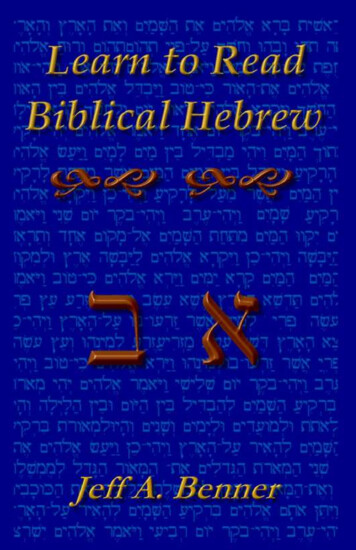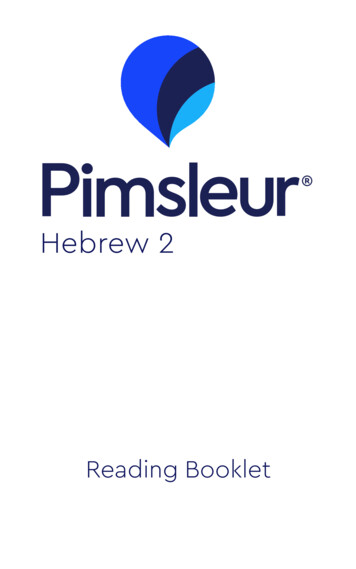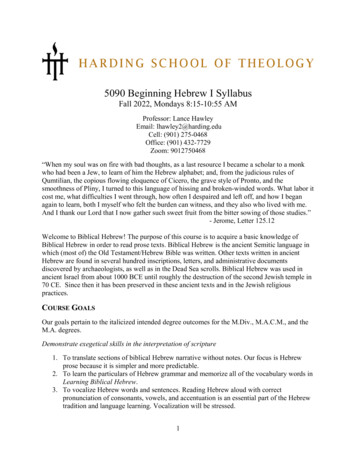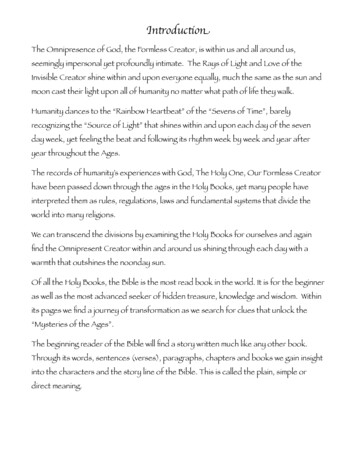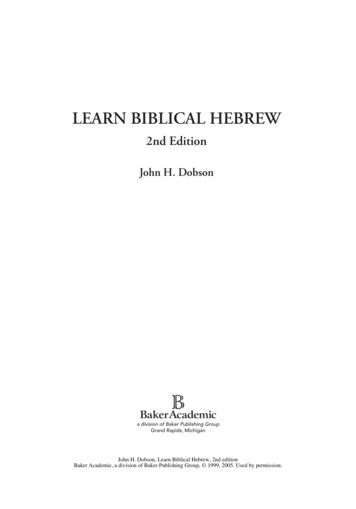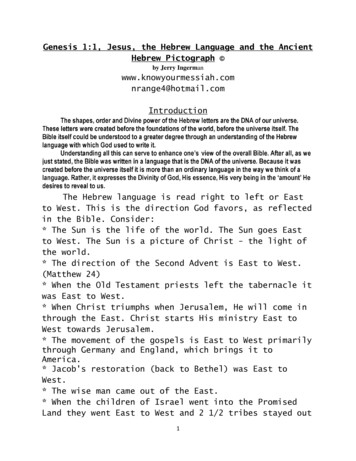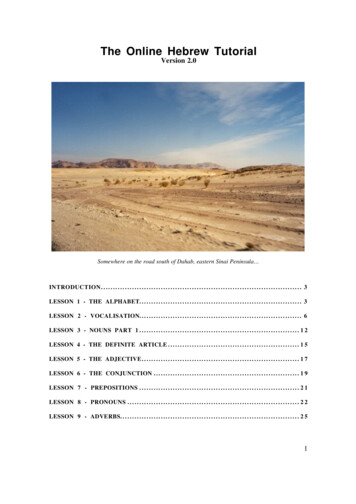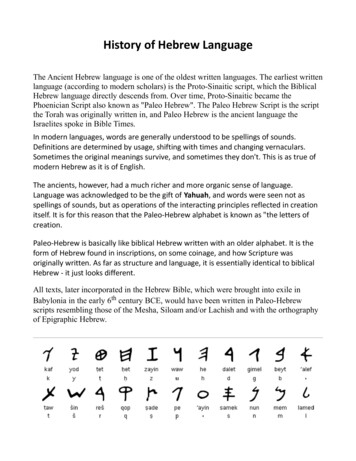
Transcription
History of Hebrew LanguageThe Ancient Hebrew language is one of the oldest written languages. The earliest writtenlanguage (according to modern scholars) is the Proto-Sinaitic script, which the BiblicalHebrew language directly descends from. Over time, Proto-Sinaitic became thePhoenician Script also known as "Paleo Hebrew". The Paleo Hebrew Script is the scriptthe Torah was originally written in, and Paleo Hebrew is the ancient language theIsraelites spoke in Bible Times.In modern languages, words are generally understood to be spellings of sounds.Definitions are determined by usage, shifting with times and changing vernaculars.Sometimes the original meanings survive, and sometimes they don't. This is as true ofmodern Hebrew as it is of English.The ancients, however, had a much richer and more organic sense of language.Language was acknowledged to be the gift of Yahuah, and words were seen not asspellings of sounds, but as operations of the interacting principles reflected in creationitself. It is for this reason that the Paleo-Hebrew alphabet is known as "the letters ofcreation.Paleo-Hebrew is basically like biblical Hebrew written with an older alphabet. It is theform of Hebrew found in inscriptions, on some coinage, and how Scripture wasoriginally written. As far as structure and language, it is essentially identical to biblicalHebrew - it just looks different.All texts, later incorporated in the Hebrew Bible, which were brought into exile inBabylonia in the early 6th century BCE, would have been written in Paleo-Hebrewscripts resembling those of the Mesha, Siloam and/or Lachish and with the orthographyof Epigraphic Hebrew.
We need to state clearly here all Hebrew scripts go from right to left, the opposite of ourmodern English language. All ancient languages go from right to left. Paleo Hebrewwas the ONLY script the Scriptures (TaNaK) were written with until after the returnfrom the Babylonian exile. After the Exile, the Prophet and Scribe Ezra, changed thescript to the script we use today, ironically called “Biblical Hebrew. In reality, this scriptis really the ancient Aramaic Script. Aramaic was the language of the Babylonians andPersians. The Jews in exile in Babylon and Persia had grown accustomed to this foreignlanguage during the Exile.The Aramaic language had the same 22 letter alphabet as Paleo Hebrew. The letters hadthe same names, and same sounds, but looked different. (Compare the chart below withthe chart above). Ezra began using the Aramaic Script (and established the AramaicScript as the ONLY Script for Biblical manuscripts) to make it easy for the IsraeliteExiles to re-learn their Scriptures and their ancient faith.The Script Ezra used (Aramaic) is still the script we see today in Hebrew TaNaKs andSiddurim. (The word "Siddurim" comes from the Hebrew verb "SaDaR" which means"to put in order". A Hebrew Siddur (plural "Siddurim") is a Hebrew Prayer book forsynagogue service.) Another way of stating this is to state that in our modern HebrewTaNaKs, we see the Hebrew language in Aramaic letters. Here is the Biblical Hebrew(Aramaic) Aleph Bet (Alphabet):The ancient Hebrew language (including Paleo Hebrew and Aramaic) did not have awritten system of vowels. Only the consonants were written. Between the fifth and tenthcenturies of the Common Era, Karaite Hebrew Scribes (called the Masorites) of the BenAsher family developed a system of vowels to be added to the Biblical Hebrew texts.
The Texts they codified became known as the Masoretic Text. These vowel “points wereadded to the text in a way that the consonants were not changed. The vowels are asystem of dots and dashes above, below, and in between the Hebrew consonants. Thedoctrine of inerrancy (that the TaNaK was written by Elohim through men, and isinfallible) to a Hebrew means that the consonants are inerrant, whereas the vowels arejust an aid for pronunciation. It is imperative to understand that the consonants are theonly factor in determining the meaning of a Hebrew word (though the context is alsoimportant). The vowels were not completed and added to Torahs by the Masoreticscribes until c. 980 CEA significant part of the authoring, and most of the redacting of the Pentateuch, theDeuteronomistic History, the major prophetic books etc. took place in Babylonia fromc. 590 BCE to c. 450 BCE. The language of that area was Aramaic. Presumably duringthat exile span of time the redaction of scriptures probably went hand with:1. Aramaic displacing Hebrew as the spoken language of the exiles;2. The rapid acceptance of the Imperial Aramaic script for writing both Hebrewand Aramaic; and,3. An increased and more uniform use of vowel letters in Hebrew writing, partlyunder the influence of Aramaic spelling conventions and partly to distinguishHebrew from Aramaic pronunciation of cognate words and forms. It is of coursepossible that this orthographic change took place without the acceptance ofAramaic script.It is probable that the Torah, as a whole, the Deuteronomistic History, the majorprophetic books etc. were “published” initially in the Aramaic script in Babylonia. Ofcourse the redactors would have drawn on documents written in the Paleo-Hebrewscripts and the orthography of Epigraphic Hebrew. Thus it may be that all Paleo-Hebrewbiblical texts (e.g. the Qumran Paleo-Hebrew Leviticus scroll, the Samaritan Torah) atone stage passed through a form in Aramaic letters. It is likely that some of the laterbooks of the Bible, such as Esther, Proverbs, Qohelet, Jonah, Daniel etc. were composedin Aramaic script.In examining likely errors, it is necessary to consider –1. Word Division - Paleo-Hebrew texts usually used clear dots to separate wordsthus minimizing the likelihood of an error in word division. Biblical texts in theAramaic-Square Hebrew script seem to have used blank spaces between words.
2. Confusion of Letters (see tables of scripts in The Book of Hebrew Script:History, Palaeography, Script Styles, Calligraphy & Design by Ada Yardeni)a) Paleo-Hebrew Script – In Mesha and Siloam scripts confusion of letters isunlikely. Lachish script, being squat and somewhat cursive, errors are morepossible if the document were written in a very small hand it might perhaps be.(p) פ n) and) נ possible to confuseb) Aramaic-Square Hebrew Script – In Babylonia, the Jewish exiles would haveadopted one or more versions of the Imperial Aramaic Script. The later JudeanJewish developments of the script are known as Square Hebrew or Jewish Script.The rapid evolution of this script as the script changed, so changed the lettersthat could be easily confused. Eg. in the Herodian script of the first centuryBCE, waw, yod and zayin could be confused as could he and het.The problem is that a single line of texts copied might go from Mesha script to Lachishscript to Imperial Aramaic script, to 3rd century BCE Jewish script to Herodian scriptpotentially exposed to changing sets of possible letter confusions at each stage. A lesslikely line of development might be from Mesha script to Lachish script to early SecondTemple Paleo-Hebrew script, to 3rd century BCE Jewish script to Herodian script.Modern Hebrew LanguageMany non-Jewish people in the world today never seem to ask the question of whatlanguage the so-called Jews are really speaking. Overwhelmingly it is assumed that theyare speaking the ancient language of Hebrew. This could not be further from the truth.The Khazarian (Turkic) people that call themselves Jews actually speak Yiddish. In factthe word Yiddish means Jewish which comes from the word Yid which means Jew. SoYiddish is not to be confused with Hebrew. In fact the Khazarian a.k.a. Jewish/ Yiddishlanguage originated in the Ashkenazi culture that developed around the 10th century.Yiddish seems to only be a hybrid of Hebrew sounds and heavy medieval German/Slavicdialects. Yiddish takes three-quarters of its vocabulary from German, but borrowswords liberally from their version of Hebrew and many other languages from the manylands where Ashkenazi Jewish speaking people have lived. It really has a grammaticalstructure all of its own and its writings are based on a made up alphabet loosely basedon the Hebrew characters of the Alphabet.The language emerged right out of Rhineland Germany and then spread to Central andEastern Europe and eventually to other countries. It developed by taking different
dialects such as German, Slavic, Aramaic, Romance languages and of course Hebrew. Inshort it is a Germanic language with Hebrew influence.Around the 10th century during this period, the Masoretes of Tiberias established theHebrew language orthography, or niqqud, a system of diacritical vowel points used inthe Hebrew alphabet. They also use a system called Cantillation of the HebrewScriptures. Cantillation means to chant. This would allow them to change or modifyparagraphs and verse divisions that could not be understood easily.Having to so-call modify the pronunciation, paragraph and verse divisions andCantillation of the Hebrew Scriptures with a system of pronunciation and grammaticalguides is a clear sign that the Jews were not true Israelites (Yahu's). They could notunderstand the Hebrew scriptures in it's original form. The true Israelites (Yahu's) werenever told to use a system called Cantillation or chant anything from the HebrewScriptures. The true Israelites (Yahu's) never needed vowel points to speak are writethe language of Hebrew. Only an outsider would need this to understand how to speakand pronouns the words properly.Yiddish is the primary spoken language of the Khazarian (Turkic) Ashkenazi Jews. It iswritten in a loose version of the Hebrew alphabet or just it's very own version alltogether. It appears the Jews did away with the Hebrew letters and formed their ownletters but tried to keep the sounds intact. Notice the huge difference in the ModernHebrew alphabet the Jews write and the ancient Paleo Hebrew alphabet.Hebrew (Modern/Paleo) AlphabetHebrew letter א Paleo-HebrewletterEnglish NameAleph
ב Bet ג Gimel ד Dalet ה He ו Waw ז Zayin ח Heth ט Teth י Yodh ך / כ Kaph ל Lamedh ם / מ Mem ן / נ Nun ס Samekh
ע Ayin ף / פ Pe ץ / צ Tsade ק Qoph ר Resh ש Shin ת Taw
"to put in order". A Hebrew Siddur (plural "Siddurim") is a Hebrew Prayer book for synagogue service.) Another way of stating this is to state that in our modern Hebrew TaNaKs, we see the Hebrew language in Aramaic letters. Here is the Biblical Hebrew (Aramaic) Aleph Bet (Alphabet):


